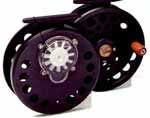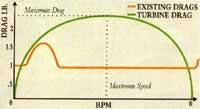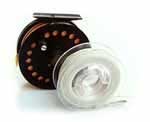A Tale of Two Reels© by Doug Macnair
A Tale of Two Reels© by Doug Macnair
By Doug Macnair
Look closely at what’s happening to the environment, and it isn’t outlandish to conclude the outlook for planet Earth is bleak. The year of our Lord 1997 has proved to be remarkable year. Mother Nature continues to take heavy hits. Despite the well-intended efforts of a few, the many continue to pollute of our rivers, streams, and coastal waters. Check the latest news and, it seems more and more of the Nation's fisheries are becoming contaminated by "bugs." Then too, acid rain continues to fall, and, as if that’s not enough, global warming is on the increase. According to scientists retained by Greenpeace, the condition may soon threaten Arctic wildlife. Mother Nature’s revenge is also evident -- storms increase in their severity resulting in death, destruction, and one-thousand year floods. I, for one, believe its too bad humankind seems hell bent on self-destruction.
I suppose that’s what life is all about -- to have the wisdom to know the things you can change and those things you cannot." Perhaps, that’s one of the reasons why I like fly fishing. Besides being an art form, fly fishing is a way to contemplate God’s wondrous works; always with the hope things will get better. When you are at peace with Him, the liars of the world mean little.
I first wrote these word in 1997, now it's 2001. So what's changed? Little, it seems to me! The latest news tells me that gas is going to hit 3-bucks a gallon this summer. That sure as hell will hurt fishing since most folks use cars to get from here to there … On the other hand, the fish may flourish given the reduced fishing pressure.
Not everything, however, is bad news. We have a new leader, who I believe, will do his best to balance the needs of environment against the needs of people and the economy. If you focus on fly fishing, some of the developments of 1997, particularly in the world of fly reels, remain accomplishments worthy of 2001. Until '97, only the "big-time" reels could sustain repeated exposure to the violent runs of a "big-time" fish. Of course, "big-time" reels cost "big-time" money. (I use the term, "big-time" to describe sums of money most of us simple folk did not have then and probably do not have now.) In 1997, two new reels came into being marking '97 as a "reel year." While the two reels discussed in this update are not inexpensive, neither meets my definition of "big-time" cost. They remain today very worthy of your consideration.
 The STH/Cortland Turbine Reels. Talk about bringing something new to the world -- the world being the world of fly fishing -- and you must be talking about Roberto Sacconi’s latest invention, the Turbine fly reel. Sacconi, president of STH Reels, is also the inventor of the cassette reel, a concept to be explored later. His Turbine was certain to be widely debated and discussed because it is a departure from everything we’ve ever known. In my view, the debate proved nothing!
The STH/Cortland Turbine Reels. Talk about bringing something new to the world -- the world being the world of fly fishing -- and you must be talking about Roberto Sacconi’s latest invention, the Turbine fly reel. Sacconi, president of STH Reels, is also the inventor of the cassette reel, a concept to be explored later. His Turbine was certain to be widely debated and discussed because it is a departure from everything we’ve ever known. In my view, the debate proved nothing!
As you may or may not be aware, the high-end fly reels typically feature a very smooth disk drag. While the exact designs remain proprietary, most are fabricated of cork, a synthetic material, metal, or a combination thereof. The problem with any drag has always been two-fold: first, overcoming start-up inertia during the surge of a strike without tippet break-off; and second, efficiently and effectively dissipating heat during the long run of a strong fish.
 So what’s new? The Turbine! It features a revolutionary drag system using an impeller immersed in a multi-viscosity oil. The impeller is hidden beneath the "hump" on the backside of the reel. When the reel spool is stationary, drag is non-existent; consequently, overcoming start-up inertia is not a problem. But after the surge of the strike, the drag begins to work -- the faster the fish runs, the faster the impeller turns (RPM); and, the faster the impeller turns the greater the drag placed against the fish. As the fish slows its run, the RPM of the impeller slows and the drag decreases accordingly. If the fish stops, the drag is released. Think about it! No drags to set; no concerns about break-off at the strike; no worries about increasing drag on a long running fish. The fish, in fact, fights the reel, not the fly fisher. It’s almost like having a built-in computer. This reel requires little thought.
So what’s new? The Turbine! It features a revolutionary drag system using an impeller immersed in a multi-viscosity oil. The impeller is hidden beneath the "hump" on the backside of the reel. When the reel spool is stationary, drag is non-existent; consequently, overcoming start-up inertia is not a problem. But after the surge of the strike, the drag begins to work -- the faster the fish runs, the faster the impeller turns (RPM); and, the faster the impeller turns the greater the drag placed against the fish. As the fish slows its run, the RPM of the impeller slows and the drag decreases accordingly. If the fish stops, the drag is released. Think about it! No drags to set; no concerns about break-off at the strike; no worries about increasing drag on a long running fish. The fish, in fact, fights the reel, not the fly fisher. It’s almost like having a built-in computer. This reel requires little thought.
 Does the Turbine work? You bet! From my point of view, it works like a champion -- it works so well, it’s the first time I can recall having ever heard the ancient Fish Gods roll over in their graves an moan. While I have yet to have a record redfish on the end of my line, those hookups I’ve had brought the fish to the net quickly, defeated by the reel, not me. What more could you ask? Not much, because the Turbine carries a lifetime warranty on materials and workmanship.
Does the Turbine work? You bet! From my point of view, it works like a champion -- it works so well, it’s the first time I can recall having ever heard the ancient Fish Gods roll over in their graves an moan. While I have yet to have a record redfish on the end of my line, those hookups I’ve had brought the fish to the net quickly, defeated by the reel, not me. What more could you ask? Not much, because the Turbine carries a lifetime warranty on materials and workmanship.
Just in case you did not know, Cortland is the exclusive marketing representative and distributor of STH reels in the United States. Thus, it isn’t surprising two versions of the Turbine will be available. The Cortland version features a traditional reel spool while the STH version features the "pop" cassette, another Sacconi invention. I elected to evaluate the STH version of the Turbine, setup for an 8-weight line. As a frugal Scot, I happen to be captivated by the cassette concept. Check the cost of spare spools for any high-end reel, and the drop-in cassette, at the cost of only a few dollars, is an attractive alternative. Want to change lines? Simply "pop-out" the cassette in use, and "pop-in" the replacement and continue to fish. It is as simple as that!
Since these words were first laid down, Cortland and STH have added new models such as the inexpensive IM "POP" Cassette. I'm pleased to report that, with the exception of one minor failure, my STH reels remain in perfect working order.
The Mastery Reels by Scientific Anglers. Scientific Anglers (SA) brings to the "reel" world another series of winners under the Mastery name. Each of the four (4) reels in the series is explicitly designed to do everything and anything anyone could ever ask of a fly reel. In the line of four, two reels are naturals for freshwater and two for the salt; of course, that doesn’t mean that the reels for the salt cannot be used in freshwater. In fact, the 8/9 is perfect for muskies, pike, steelhead, lake trout, and largemouth bass. The model numbers are a dead giveaway as to the line size each reel best accommodates.
As you might suppose, the freshwater models, 45 and 67, have a wide ranging drag setting. Using a small "DE4-P" drag incorporating a pair of PTFE-impregnated pads within an enclosed system, both reels offer a smooth drag programmed for a lifetime of maintenance-free, dependable use. All DE4 drag reels feature a 4-ball bearing direct compression design using high-tech pad materials. Overcoming start-up inertia is not a problem with either reel, assuming the fly fisher doesn’t do something stupid such as incorrectly setting the drag.
The two larger reels are built to take on anything, anywhere -- as long as it swims. On second thought, I doubt that either reel is up to a fight with the infamous Great White, "Jaws." The saltwater models, 89 and 1011, are obviously suitable for line sizes in the heavier weights. Both reels have very adequate capacities for the backing of your choice. Talk about a drag system -- both the 89 and 1011, feature a large "DE4-X" carbon disk drag designed to dissipate heat when a large fish decides to "head out yonder." The drag pad material is new-to-the-industry aviation carbon. According to SciAnglers, lab tests have proven the drag exhibits only a 3-4 degree temperature increase in 200 yard runs at 22 mph and lasted the full 3.5 minutes "burn-out" test at 30 mph. (That’s probably enough to handle Jaw’s little brother.)
Are these reels tough? You bet! The quality is typical of anything that bears the Scientific Anglers logo. All reels in the Mastery series feature a lifetime warranty and are fabricated from bar stock aluminum. To resist corrosion, each component is either plated or deeply black-anodized -- twice the industry standards. However, this is not meant to imply you should neglect "reel" tender loving care after fishing the salt.
For my purposes, I selected the 8/9, a size that goes nicely back-and-forth between salt and freshwater. Married to either a Sage RPL-X or a Fish Creek Northfork, the reel felt right at home in my hands. Because I prefer not to set a drag in advance of a strike, I was extremely pleased with the reel’s performance. With some reels, a "zero" drag setting is ill-advised because the reel will overrun as you strip-out line. There is no such problem with this reel. Fishing the 89 is a delight. This reel communicates, "I am a true, loyal and reliable companion."
I must tell you that I now own a 67 and a 1011. Both have proven to be fantastic reels! While there are reels possessing more intrinsic beauty, there are few, if any, that can run with these workhorses.
Conclusion. Believe it or not, water sometimes passes over the dam ever so slowly. Whenever you create something new, there are those who are quick to try the product and others who hang back awaiting the results. If you are one of those who waited, wait no longer. Depending on your needs both of these multi-series reels offers you an interesting contrast in versatility. For big fish, the Mastery is my choice over reels twice the cost. For folks who need several lines for lighter fish, check out the cassette system of STH, and for those of you defeated by setting drags, try the Turbine -- besides, STH has added a manual drag just to make everyone happy.
For more information, contact:
3M Scientific Anglers, 3M Center, Bldg. 223-4NE-05, St. Paul, MN 55144-1000. Telephone: 1-(800) 525 -6290.
Cortland Line Company, P.O. Box 5588, Cortland, NY 13045-5588. Telephone: 1-(607) 756-2851.
© Copyright: Douglas G. Macnair, 1997-2001.
|
